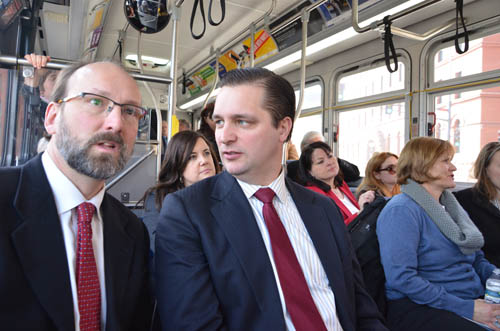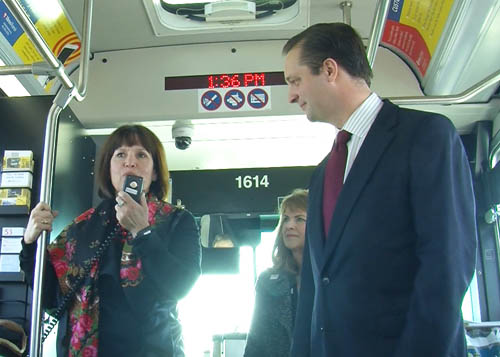Gateway Project Facts
- Mode – Bus Rapid Transit
- 12 stations
- Saint Paul to Woodbury - 12 miles
- Status - draft environmental impact statement under way
- Timeline - Construction 2017, operations 2022
Metropolitan Council Chair Adam Duininck wrapped up the first week of his seven-county tour on Feb. 6 with a bus ride through the Gateway Corridor (future METRO Gold Line) in the east metro area.
The bus was filled with local elected officials and staff. It followed the proposed route of a bus rapid transit (BRT) line that will run in a dedicated guideway for most, if not all, of its 12-mile length from the Union Depot in Saint Paul to Manning Avenue in Woodbury.
“The future Gold Line is an important piece of the regional transit network and one that I strongly support and the Council supports,” Duininck said to the busload of local elected officials and staff took the tour.
The Gold Line “will be new transit technology for Minnesota,” said Washington County Commissioner Lisa Weik, who co-chairs the Gateway Corridor Commission. “It is bi-directional, all day, evening and weekend service in restricted bus lanes to the east metro.”
Dedicated transit is catalyst for development
 BRT attracts robust economic development around station areas, Weik said, and it will provide an opportunity for redevelopment in the Ramsey County portion of the line and for greenfield and new development in Washington County.
BRT attracts robust economic development around station areas, Weik said, and it will provide an opportunity for redevelopment in the Ramsey County portion of the line and for greenfield and new development in Washington County.
In 2010, the corridor had 87,500 jobs within one mile; in 2030, that number is expected to grow to 149,000. In addition, thousands of students attend post-secondary schools along the line. The corridor population is expected to grow from 64,600 in 2010 to 89,600 in 2030.
Businesses, including Fortune 500 3M Company, support the BRT line
 The tour included a stop at 3M’s corporate headquarters, where former State Rep. Douglas Stang—now in government relations for 3M—talked about how the company has embraced BRT for its promise of bringing workers to the sprawling campus and helping to alleviate parking issues.
The tour included a stop at 3M’s corporate headquarters, where former State Rep. Douglas Stang—now in government relations for 3M—talked about how the company has embraced BRT for its promise of bringing workers to the sprawling campus and helping to alleviate parking issues.
The business community solidly supports the line, said U.S. Rep. Betty McCollum, Saint Paul. She also said that East Siders know how to “put aside party labels” to work together for what’s best for the east metro.
“I think it’s appropriate that we’re the Gold Line because we think we’re the gold standard out here on how you bring everybody together to move something forward,” she quipped.
Gateway seeks state funding to continue project development
The Washington and Ramsey regional railroad authorities are requesting $3 million from the state legislature this year to continue project development. Total project cost is estimated at $485 million, funded as follows:
-
Ramsey and Washington counties, $24 million (5%) each
-
State, $48.5 million (10%)
-
Counties Transit Improvement Board, $170 million (35%)
-
Federal, $218 million (45%)
The Gateway Corridor is part of a growing network of transitways in the seven-county metro region designed to boost the region’s economic competitiveness and livability by giving people alternatives to driving in congested corridors and freeing up lane miles for freight movement.
Cultivating relationships with local officials
Developing strong relationships with elected officials around the region and listening to their concerns is one of the new Council Chair’s top priorities. The week of Feb. 9, Chair Duininck is visiting with Ramsey County officials, followed by Dakota County the week of Feb. 16.
“I really look forward to cultivating these important relationships with local officials—the mayors, city council members, and staff —who are working to make their communities and the region a better place to live, work and raise a family,” Duininck said.
More information